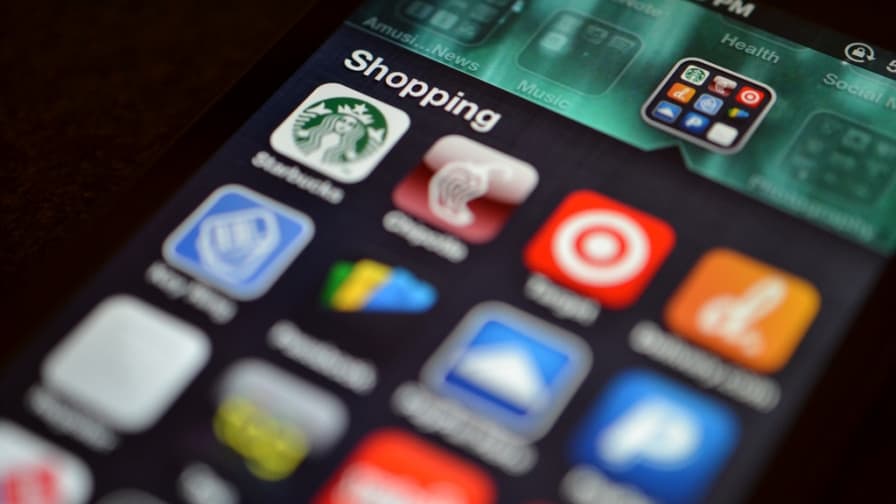In short, a mobile wallet is an app or technology that allows a consumer to replicate the functions of a real wallet, on their mobile phone. This means consumers can make payments (for example using PayPal) or store boarding passes, event tickets and crucially, voucher codes.
What makes mobile wallets so exciting is that if mobile is the bridge that crosses the worlds of offline and online, then mobile wallets is the pivot that will be driving the growth in m-commerce.
The m-commerce market is predicted to grow to $5.25 trillion worldwide by 2020, and this is why…
Payments
The future is a cashless society and mobile wallets offer the potential of a virtual plastic economy. When did you last try to pay for your journey on a London bus with money?! Imagine your card details stored on your phone and being able to pay for items with just one click/fingerprint – it’s quick, simple and effortless.
Contactless communication
Whether the triumphant technology ends up being NFC or iBeacons (BLE), or perhaps both, mobile wallets can connect online marketing activities with bricks and mortar stores. At present, 90% of consumer retail spend is offline so mobile wallets presents the opportunity to open up digital marketing spend, to drive consumers into the store.
Marketing to customers
This is where the talk becomes reality. Apple Passbook already allows for voucher codes to be saved to the phone, so consumers can save offers for use later at their convenience, rather than having to either use them immediately or try to remember them for later. This is extremely important as too often, mobile users are time poor or have varying connectivity through 3G coverage.
The result is that voucher codes and special offers are often ignored or forgotten about by consumers on the move. Apple Passbook solves this problem by ensuring coupons are always with consumers on their mobile devices, up-to-date, and safely stored. Moreover, Apple Passbook allows advertisers to push messages to customers with expiry reminders, plus geo-targeted nudges and updates, to encourage engagement with prospective consumers in a manner that has never been possible to marketers – until now.
Scale
Apple Passbook is already pre-installed onto every iPhone and iPod Touch – that’s more than 300 million units worldwide. With Samsung having launched a mobile wallet and Google rumored to have set a date in H1 2014, developing a mobile wallet strategy doesn’t seem so niche anymore.
With this in mind, why has adoption been slow in the UK so far?
Firstly, 45% of businesses still don’t have a mobile site or app. It seems as if many businesses are late to the game and are struggling to get to grips with the basics of mobile marketing, before they can even explore the more advanced elements. Next you have to consider the chicken and the egg dilemma. With few brands taking advantage of Apple Passbook, consumers are naturally less inclined to interact with it. Lastly, while Passbook is pre-installed in every iPhone (iOS6 or above), Samsung’s mobile wallet isn’t pre-installed in UK devices, and Google’s Wallet is yet to launch in the UK.
Perhaps it is worth casting our eyes over the pond to the USA in order to get a taste of things to come. 59% of Americans are aware of Google’s Wallet, while Passbook is the fourth most popular mobile commerce app, alongside eBay, Amazon and Groupon, with one fifth of iPhone users using Passbook to download passes. When it comes to technology, the UK patterns of adoption tend to follow the USA.
Already, British consumers are ahead of the game for e-commerce and m-commerce whether it is average spends online, mobile adoption or consumption. Nearly 60% of respondents to a recent UK study said that they were open to using mobile wallets in the UK. Google Wallet is set to launch in 2014 and with circa 60% of smartphones having Android as its operating platform, UK consumers will begin to embrace their phone for m-commerce.
Looking to tomorrow
The stage is set and Tradedoubler has already seen some positive results in the beta launch of its Apple Passbook Solution; in one campaign, we delivered a redemption rate of 8.5% for a voucher code that we ran. This figure was for redemptions made through the same mobile device and what makes it even more exciting is that it was for a display campaign. Encouraging performances like this gives the industry confidence that 2014 will see many more marketers exploring the mobile wallet space.
Finally, take a look at Starbucks, the trailblazer of the multichannel retail industry, which integrated Apple Passbook into their app soon after the launch of iOS6 last year. Starbucks is currently generating 10% of its store transactions through mobile devices. It proves there is a future for mobile wallets…

